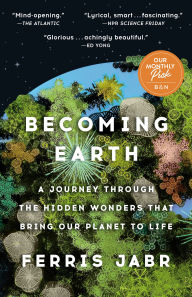Life is Earth Animated: A Guest Post by Ferris Jabr
What’s the first thing you think of when you think of our planet? Be prepared to reconsider everything you think, know or believe to be true, thanks to this engaging and thoughtful new look at our world. Read on for an exclusive guest post from Ferris Jabr on our Monthly Pick, Becoming Earth.
Becoming Earth: A Journey Through the Hidden Wonders that Bring Our Planet to Life
Becoming Earth: A Journey Through the Hidden Wonders that Bring Our Planet to Life
By Ferris Jabr
In Stock Online
Paperback $20.00
A vivid account of a major shift in how we understand Earth, from an exceptionally talented new voice. Earth is not simply an inanimate planet on which life evolved, but rather a planet that came to life.
A vivid account of a major shift in how we understand Earth, from an exceptionally talented new voice. Earth is not simply an inanimate planet on which life evolved, but rather a planet that came to life.
The seeds of this book germinated in a forest—a forest so vast and powerful that it makes its own weather and influences global climate.
Many years ago, when I was in grad school, I learned an astonishing fact: the Amazon rainforest does not simply receive the rain on which it depends—it summons it. The Amazon generates about half of the rain that falls on its canopy each year. The forest pulls huge volumes of water from the soil, releasing what it doesn’t need to the atmosphere. In parallel, it spews invisible plumes of tiny biological particles: pollen grains, fungal spores, microbes. All the water vapor expelled by the forest condenses onto that floating potpourri of biological detritus, accelerating the formation of rainclouds. And through long-range atmospheric ripple effects, the forest changes weather patterns on other continents, as well as the planet’s climate as a whole.
Learning to see the Amazon this way was a revelation. I’d always been taught that life adapts to its environment, not the other way around. I knew that some creatures, such as beavers, could significantly modify their local landscapes. But the Amazon’s influence was much more profound. I began to wonder how else life has shaped the planet.
The more I looked, the more examples I found. Life has been an agent of planetary transformation for most of Earth’s 4.5-billion-year history. All manner of organisms, from microbes to mammoths, have radically altered the continents, atmosphere, and ocean. Life is why we have a blue sky, an oxygen-rich atmosphere, and fire. Life vastly expanded the planet’s mineral diversity, created fertile soils, and maybe even helped form the continents. The long, ongoing coevolution of Earth and life is responsible for many of the planet’s defining features, turning what was once a lump of orbiting rock into our cosmic oasis. Such insights are part of an intellectual renaissance revolving around a field known as Earth system science: the holistic study of the planet’s animate and inanimate components as a single interconnected system.
Life is also an integral part of Earth’s ability to regulate itself. Throughout its long history, our planet has continually oscillated between tempestuous hothouse states and deep freezes. Yet it also has an innate, albeit limited, capacity to gradually restabilize its climate over tens of thousands to millions of years. Life has been entwined with this self-regulating process, and has amplified aspects of it, for billions of years. In general, given enough time and opportunity, Earth and life tend to make each other more resilient and enduring. Despite the many calamities that have befallen our planet, it has remained alive for more than four billion years.
The more I studied the intimate connections between Earth and life, the more I came to see them as one. One of the central messages I hope readers glean from this book is that life not only changes Earth—life is Earth. Life is, quite literally, a physical extension of the planet. The matter of life is the very same matter of Earth. Life is Earth animated.
I’ve always felt a reverence for nature, but after writing this book, I now experience my connection to our astounding planet more viscerally than ever before. Though it may not be apparent at first glance, the truth is that we are just as much an outgrowth of Earth as a tree in a forest. Like every creature with whom we share this world, we are continuous with our planet, bonded in reciprocal evolution, both equally and miraculously alive.
